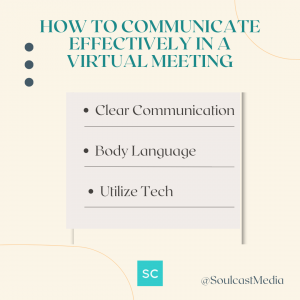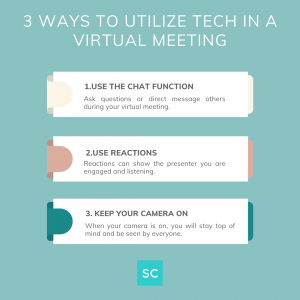How To Effectively Communicate In A Virtual Meeting
More and more companies embrace work from home or some hybrid work situation. According to Modality, 89% of users say video conferencing helps them feel connected. Because of this, you must learn how to communicate in a virtual meeting effectively. It is still important for you to stay visible and have your ideas heard.
Virtual meetings present their share of communications complications because you aren’t physically in the room with others.
However, you can learn to communicate in a virtual meeting by focusing on clear communications, body language, and utilizing the technology effectively.
Below are three strategies to help you learn how to effectively communicate in a virtual meeting.
1. Clear Communication
Clear communication is critical in any meeting; however, this is especially true in a virtual setting. When you are in a virtual meeting, you don’t have the luxury of having conversations before and after the meeting. You also may be under tight time constraints. Being clear in your communication from the start will help you get your message across the first time.
Consider the following:
- Clear + Concise – When you are in a virtual setting, it is easy for you, and others to get distracted. Because of this, you will want your communications to be clear and concise. This means getting rid of filler words and avoiding mumbling or tangents. Filler words are like uh, um, you know, etc. These words make it difficult to understand your message. Mumbling can make it hard for others to hear you. For example, speaking under your breath, or not enunciating are forms of mumbling. Going on tangents can make people tune out while you are speaking. Be sure you get straight to your point.
- Active Listening – Active listening is critical for clear communication. If you aren’t actively listening during the meeting, you won’t respond appropriately. There are several ways you can practice active listening. For example, taking notes shows you are listening and engaged during the meeting. You can also paraphrase while responding to show you were paying attention. For example, you can say something like, “Jim, I think what you were trying to say was xyz, am I correct?” Listening will help you effectively communicate in the meeting.
- Speak Up – To have your ideas or thoughts heard, you have to speak up. Speaking up can be scary, but it doesn’t have to be. There are several ways you can speak up. For example, if you aren’t presenting, you can raise your hand and ask to speak when the presenter is finished with their thoughts. Or you can utilize the chat function to ask a question. Effective communication requires you to speak up at the right time.
Clear communication will help you be more effective in a virtual meeting.
2. Body Language
In a virtual setting, being aware of your body language is very important. This is because body language is heightened in a virtual setting. Being aware of your eye contact, facial expressions, and gestures will help you effectively communicate.
Consider the following:
- Eye Contact – Eye contact in a virtual meeting is just as important as an in-person meeting. This is because eye contact communicates to the presenter that you are engaged. There are two different ways to maintain eye contact in a virtual setting. You will want to look directly at your camera if you are speaking. This will make it seem like you are looking directly at those listening. If you are not speaking, you can look at the screen.

- Facial Expressions – In a virtual meeting, your facial can seem heightened to others. This is because most people can see your upper body, and the screen enlarges these images for everyone. Because of this, you will want to be very aware of what your facial expressions are saying. For example, if you aren’t on board with what the presenter is saying and you roll your eyes, or shake your head, you are communicating your displeasure with what they are saying. This may not be the message you want to send. Smiling and nodding your head are two ways to show the presenter that you are engaged and listening to what they say.
- Gestures – When speaking in a virtual meeting, you will want to use gestures to emphasize your point. For example, take your hand off your mouse to free up your hands. You can use your hands to explain your points by holding up fingers. Using gestures will help effectively communicate your point in a virtual meeting.
Body language is a powerful communication tool. Maintaining good eye contact, being aware of your facial expressions, and using gestures will help you effectively communicate in a virtual meeting.
3. Utilize Tech
Virtual meetings allow you to utilize different tech aspects to help you communicate. Even if you aren’t actively speaking, the tech options in virtual meetings give you the opportunity to stay engaged.
Consider the following:
- Chat Function – The chat function is a great way to communicate with others during your meeting. For example, if the presenter is speaking, you can ask a question in the chat function to not interrupt. Or, you can send a private message to a team member with a question or idea. The chat function can help you communicate and interact with your team members.

- Use Reactions – Reactions can help you engage and communicate during a virtual meeting. For example, if you really enjoyed what the presenter said, you can send a thumbs up. Or, if you have a question you need to have answered in real-time, you can use the button to raise your hand. Reactions will keep you engaged and help you communicate while in the meeting.
- Keep Camera On – If you really want to show up and be seen during a virtual meeting, you need to keep your camera on. Keeping your camera on shows you are paying attention. For example, let’s say the presenter is asking a question, and you know the answer. If you don’t have your camera on, the presenter most likely won’t call on you because they can’t see you. They may assume you aren’t paying attention. Keeping your camera on will keep you visible to the presenter and everyone else in the meeting.
Utilizing tech options during a virtual meeting can help you effectively communicate.
In the end, effective communication in virtual meetings is critical for your career success. With almost every company employing some form of virtual communications, the more comfortable you become, the more effective your communications will be.
___
Whenever you’re ready, there are 3 ways we can help you:
- Discover your communications style so you know where to start. Over 4,000 people have found theirs here.
- Attend our monthly communication workshop to build communications confidence (new topics: public speaking, advocating for yourself, building credibility, etc) here.
- Get your brand in front of 43k+ people by sponsoring our newsletter or Soulcast Media | LIVE LinkedIn events [contact: hello@soulcastmedia.com]











